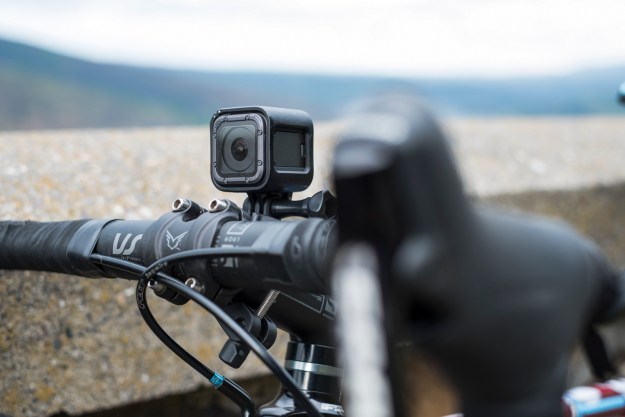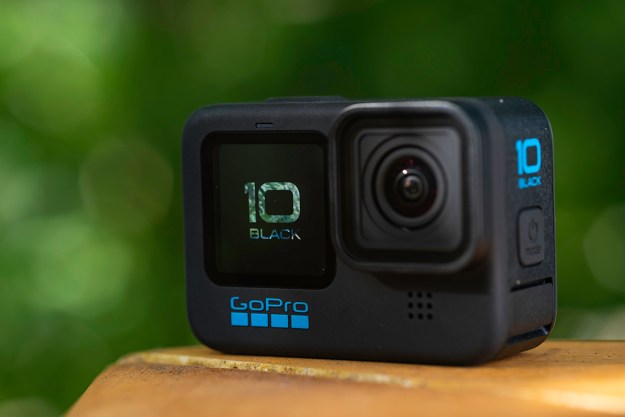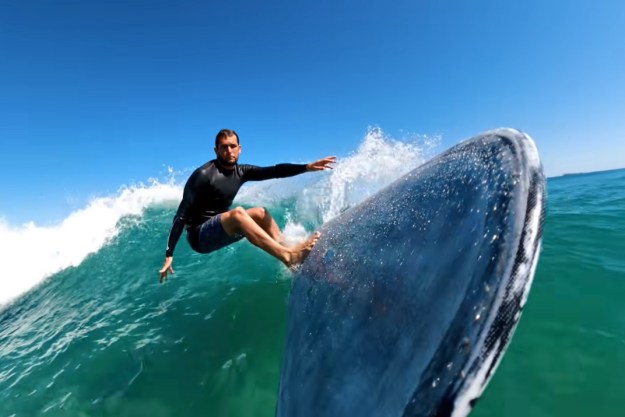
“The Hero5 Session cuts down on size and weight, without sacrificing video quality.”
- Great design
- Fast, responsive app
- Digital image stabilization
- 4K resolution
- Waterproof to 33 feet without a case
- Aggressive wind cancelling lowers audio quality
- 4K difference not always noticeable
- No removable battery
Way back in July 2015, GoPro unveiled the Hero4 Session, a miniaturized, pared down version of its action camera to complement the existing Hero4 Black and Silver models. It was smaller and cuter than the regular GoPro, but it completely missed the mark. Initially priced at $400 – neck and neck with the more capable Hero4 Silver – it didn’t do well. Less than five months after the launch, GoPro cut the price in half.
With the new Hero5 Session, sitting alongside the flagship Hero5 Black, GoPro seems intent on not repeating its previous mistakes. The first correction they’ve made is the price, which now sits at $300, $100 less than the Hero5 Black (and the original Session).
GoPro seems intent on not repeating its previous mistakes with the new Hero5 Session.
The second improvement is to the camera itself. While the Hero4 Session felt heavily truncated compared to its peers, the Hero5 Session stacks up competitively against the Hero5 Black – or at least, it appears to.
There are still plenty of reasons to opt for the top-of-the-line model, but it helps that GoPro’s entire lineup feels more streamlined this time around. There are just two Hero5 cameras, while the Hero4 Session has been rebranded as just the Hero Session and remains on as a low-end offering, at $150. Each camera has a clear place in the product line, and deciding between the three is no longer a hapless game of cross-checking specifications until your eyes bleed.
A familiar face
The Hero5 Session may be entirely new on the inside, but you wouldn’t know it just by looking. It could easily be mistaken for the entry-level Hero Session, with the same cube-like shape. There’s a lens on the front, a large record button on top, and a smaller menu button on the back. On the left side you’ll find a MicroSD card slot and, new to this generation, a USB-C port. It’s gray instead of black this time around, with the same stealthy matte coating as the Hero5 Black.
The small size of the Session will certainly make it more appealing to certain use cases, particularly for those who want a very small video camera without sacrificing specs. Beyond the reduced size and weight, it also has the slight benefit of a centered lens, compared to the Black which puts the lens a little to the left. Yes, this is a minor difference, but it’s nice to be able to get a perfectly centered shot when you want it.
The one inevitable downside of the Session’s compact design is that there’s no room for an LCD monitor, which is probably the most noticeable specification difference between the Session and the Black. Fortunately, there is a small display for viewing camera settings, which is surprisingly easy to navigate, if limited in scope. To get the most out of this camera, it’s more or less required to install the GoPro Capture app on your phone.
Hero, or sidekick?
With the Session, GoPro is very aware of one thing: convenience is king.
A cursory glance at the spec sheets of the Hero5 Black and Session is all it takes to see that these two cameras are very similar. Both offer 4K video at 30 frames per second (fps); voice control; digital image stabilization (in non-4K resolutions); and Wi-Fi and Bluetooth connectivity. The Session can submerge down to 33 feet underwater without a case – equal again to the Black.
One area where they clearly differ is in still photography, where the Black can shoot 12-megapixel stills compared to the Session’s 10. This in itself may not be a huge difference, but the Black can also save high-quality RAW photos, while the Session is limited to compressed JPEGs. Luckily for the Session, we’d hardly call the lack of RAW images a deal breaker, since we doubt most users care about having that feature in an action camera.
However, the Hero5 Black still has its advantages. In a surprise update last year, GoPro unlocked that camera’s internal GPS to enable data logging for location, course position, altitude, speed, and g-force. This information can then be overlaid on the video to provide an entertaining new dimension to your adventures. It’s a feature we really liked on Garmin’s Virb Ultra30, and definitely sets the Hero5 Black apart from other GoPros.
Furthermore, while the Session is no slouch, it won’t quite match the image quality of the Black. The newer, higher-resolution sensor in the Black can shoot 4K in the extra-wide SuperView mode, while the Session has to drop down to 2.7K or lower to use SuperView. According to GoPro, it also won’t hold up as well in darker environments, with “consumer grade” low-light capability compared to the Black’s “professional grade.” For average use, this probably won’t make much difference, but these are things to be aware of, and discerning users should opt for the Black for the best image quality.
There Hero5 Black can also shoot at higher framerates, up to 120 fps in Full HD 1080p. The Session maxes out at 80 fps in Full HD. This gives the Black an edge for capturing fast-moving action, which will translate to better slow motion with greater detail.
Additionally, the Black features a removable battery, so if you run out of juice (as you’re likely to do) you can swap in a fresh one. The Session’s battery can’t be removed, so you have to plug the camera in to recharge it. Luckily, you can do this via a USB power brick, but you’re still going to end up with some downtime in the middle of your shoot.
What’s interesting is that none of these shortcomings make the Session a bad camera; it’s still a very good value at its price. Instead, this illustrates how much more value is built into the Hero5 Black. At just $400, it’s a pretty remarkable achievement. The Session is a good choice, but the Black remains the better one – unless you really need the smallest possible camera.
User experience, image quality, and audio
With the Session, GoPro is very aware of one thing: convenience is king. When you’re in the middle of a ride, drive, or climb, fumbling with camera controls is the last thing you want to do. This isn’t an issue with the Session – with a single tap of the record button, the camera will power on and begin recording. Or, turn on voice control to speak commands like “GoPro, start recording,” or “GoPro, shoot bursts.”
GoPro’s implementation of digital image stabilization strikes a good balance between maintaining sharpness and smoothing out rough footage.
Voice control works really well provided there’s no background noise, but when you’re bombing down a hill with wind rushing around you, you’ll need to yell at the Session to get it to hear you. Depending on where it’s mounted, you also might not be able to tell if the camera acknowledged your command, leading you to needlessly repeat yourself.
GoPro’s implementation of digital image stabilization strikes a good balance between maintaining sharpness and smoothing out rough footage. That is to say, it’s not the most aggressive stabilization, so riding your bike down a cobblestone street will still look like a bumpy ride, but image softening is kept to a minimum. There’s still a noticeable crop with stabilization turned on, but given how wide-angle the camera is to begin with, we didn’t mind it.
For maximum image quality, you can shoot in 4K resolution, but keep in mind that this limits your framerate to either 24 or 30 frames per second. In our experience, shooting in
If the Hero5 Session has an Achilles heel, it’s the audio quality. It doesn’t seem to be an issue with the microphones themselves, but rather how the camera is processing the signal. When standing still, audio is good but not great – more or less what you’d expect from a small action camera. However, start moving and things get a little weird. Pick up speed, and soon you’ll sound like you’re underwater.
This appears to be the consequence of aggressive noise cancelling designed to cut out the sound of wind. We will admit it does a good job of achieving that goal, and can, in some circumstances, make voices more audible. However, it also results in audio that just doesn’t sound natural. And as we already mentioned, there is a noticeable change in sound quality from being still to being in motion, which leads to very distracting shifts in the audio if you accelerate or decelerate.
Now, there may be some room for debate here. Many users report not having any issues with the audio whatsoever. You can watch our review video above to hear a sample of what we’re talking about, but perhaps your interpretation of it will be different.
There’s an app (and a membership) for that
Thankfully, given how often you’ll need to use it, Capture is a well-designed app.
Although you don’t technically need it, we highly recommend using GoPro’s Capture app with the Hero5 Session. It opens up all kinds of control and gives you a live-view window so you can frame your shot from your phone, with virtually no lag. It also grants access to ProTune, which lets you control a number of advanced settings like maximum ISO, exposure compensation, and color profile.
Naturally, images and videos saved on the MicroSD card can be viewed, edited, and shared in the app, and GoPro Plus members can upload straight to the cloud to make their videos available on any device.
With Plus membership, you can also have the camera automatically upload footage to the cloud when it’s plugged in, although this is limited to clips shot in 1080p/30. Higher resolution clips will have to be imported manually. Members also get access to licensed music tracks and discounts on GoPro accessories. Plus membership costs $5 per month.
Thankfully, given how often you’ll need to use it, Capture is a well-designed app. It’s simple, very responsive, and way better than most other camera manufacturer apps we’ve tried. It will also alert you when new firmware is available and will even wirelessly install it to the camera. This is a nice feature, as camera firmware updates are often a hassle.
For more advanced editing, there’s the Quik app, which lets you add text, music, and filters and can automatically sort through your footage to find the best moments. If you’d still prefer to work your postproduction magic from a desktop computer, there’s a Quik desktop app, too.
Warranty information
GoPro provides a one-year limited warranty on the Hero5 Session.
Our Take
The Hero5 Session is a great little action camera. We’re especially glad to see that GoPro has worked out the kinks in its product lineup, in which the new Session has a clearly defined position. It offers significantly more features than the original Hero4 Session, all while coming in at $100 less than the original’s price. We still feel the Hero5 Black is the camera to get and is more than worth the extra $100, but if you’re after the smallest possible GoPro, then the Hero5 Session will fit the bill.
However, the otherwise great experience is marred somewhat by the poor audio. If the Session is to be a second camera, then this won’t be an issue. Or, if you’re like the many owners who don’t have (or simply don’t notice) the audio problems, then maybe it won’t matter to you at all. Either way, we recommend listening to some examples on YouTube or testing out the camera yourself (carefully) during the 30-day return period. Again, some people may not care about the issue, but for others, it could be a deal breaker.
Is there a better alternative?
If you can spring for the Hero5 Black, we say, do it – it is still the GoPro to have, and the action camera to beat. We love the Session for its small and lightweight design and pure simplicity, but if you can own only one action camera, the Black will make you happier in the long run. Even if you don’t think you need features like GPS telemetry today, you may want them down the road. Also, the Black lets you disable wind noise reduction, giving you more control over the audio quality; external mic support (via an optional adapter) makes things sound even better.
As a second camera, or in those rare cases where a larger action cam just won’t fit, then there’s really nothing out there that can compete with the Hero5 Session.
How long will it last?
Like any action camera, the Hero5 Session is built to endure a rough a tumble lifestyle. We have no reason to suspect it won’t last a long time. GoPro also seems to have built it with the future in mind, bestowing it with a USB-C port. Be warned, however, that damage resulting from accidents is not covered by the warranty, so should your Session need to be repaired or replaced within its first year, you might be out of luck.
Should you buy it?
There isn’t an easy answer here, but we’re mostly leaning toward yes. We say go for the Hero5 Black if you can, and the Session’s audio issues should not be ignored. But despite everything, we still really enjoyed using it. It’s a set-it-and-forget-it action cam that is powerful, simple, and plenty of fun. It’s not perfect, but depending on your needs, that might matter at all.
Editors' Recommendations
- The 15 best GoPro accessories in 2024
- Best GoPro deals: Save on action cameras and accessories
- GoPro Hero 11 Black leak suggests a moderate upgrade
- ReelSteady makes GoPro Player ‘reel’ useful for filmmakers
- GoPro keeps recording as parrot steals it from tourists and flies off












